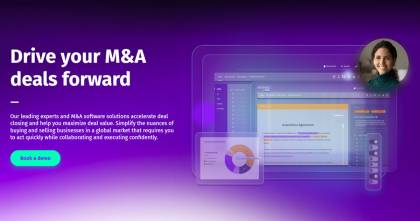Knowing what could happen to your company does not require a crystal ball. Rather, it calls for a plan to harness data to create insights, predictions and forecasts that can help you achieve your business goals. This is a chief benefit of predictive analytics, or the use of data to generate scenarios that allow you to predict how your organization can benefit from structural or operational changes. Data-driven forecasting makes it easier for you to weather fluctuations in the market and improve your decision-making.
With an increase in data volumes, faster computing and advanced algorithms, your business can use artificial intelligence to take your financial predictions to the next level. This guide shows you how predictive analytics in corporate finance can improve your reporting accuracy, compliance, insights and future planning.
Defining Predictive Analytics in Finance
Although finance experts have been using data to create forecasts and predictions for decades, the addition of AI and other technologies increases accuracy and potential. Humans can review data to see if they can identify patterns and trends that might apply to future financial situations, but they are less likely to be as accurate or comprehensive in the research.
By comparison, AI for financial reporting can use data mining to process large amounts of data into useful insights. This information can be used to create effective and accurate statistical models to predict possible results given a specific sample of data. Technology presents potential benefits for businesses in terms of estimating revenues, costs and even effects of macroeconomic factors.
While traditional forecasting relies on human understanding of financial patterns and trends, a machine learning predictive model does not need to develop a human understanding to be able to generate forecasts and predictions based on data. Machine learning describes a process of providing data sets to a model to train it to learn the connections between inputs and outputs. Over time, the algorithm refines the model’s answers for accuracy.
Machine learning models can take forecasting to the next level. Predictive analytics focuses on a data-driven approach that provides information about specific probabilities and “what-if” scenarios based on real-time data feeds. Forecasting, by comparison, usually offers broad estimations that may not provide the same level of detail.
Key Use Cases of Predictive Analytics in Corporate Finance
Companies can use predictive analytics to streamline forecasting and predictions for virtually every financial aspect of operations. These use cases identify potential benefits for the application of data-driven algorithms for financial services.
Cash flow forecasting
Cash flow management is a crucial task for many businesses, and finding the right balance can smooth out operational expenses despite fluctuations in revenue. Financial data analytics uses information about the company’s financial operations, including sales, expenses and payments, to predict changes in cash flow.
Risk management and compliance
The constant oversight of an artificial intelligence system allows companies to stay ahead of risk management and compliance. The machine learning model can identify gaps in compliance in advance, while bringing the business’s reporting in line with financial reporting trends. Anomaly detection in data analysis flags unusual activity or suspicious transactions, minimizing fraud and other risks.
M&A due diligence and valuation
While financial analytics specializes in granular detail useful in handling day-to-day operations, its benefits can apply to major financial decisions as well. Predictive models provide advantages to the M&A due diligence process by handling raw data and converting it into insights that the company can use to predict revenue streams, potential for a successful integration or post-merger problems.
Market predictions
Effective financial forecasting relies on an understanding of market trends, so that businesses can readily adapt when the market shifts. Scenario modeling allows companies to take existing data and identify patterns related to changes in the market, from stock prices to fluctuations in consumer behavior. This information can help financial institutions to plan their responses to certain market conditions.
Building a Predictive Analytics Framework
To build a predictive analytics framework that emphasizes accuracy and efficiency, companies must utilize foundational elements that help them achieve these goals. To start, businesses should employ skilled analysts with an understanding of corporate finance. These key aspects can help in the design of a system that works for the organization:
- Data Strategy and Governance: Data must be verifiable and secure to generate useful, safe results. Ensuring data cleanliness and tamper-proof record-keeping, along with robust information security, protects financial institutions and partners from negative effects.
- Technical Infrastructure: Accurate predictions rely on an integrated system that removes data silos and other barriers to data processing. Cloud-based solutions and big data platforms simplify the process of collecting, managing and processing large amounts of financial data.
- Iterative Approach: The iterative approach of machine learning allows the system to improve with testing, feedback loops, and incremental refinement. This tactic creates opportunities for greater accuracy in forecasting, as well as increased compliance as part of the financial reporting process.
Investing in the integration of systems that prize accuracy and consistency can help companies to ensure that results meet expectations over time.
Impact on Governance, Compliance and Strategic Decisions
Access to data-driven scenarios, predictions and insights creates a path for businesses to improve their governance, compliance, and strategic decisions. Organizations can use data analytics in SEC reporting software to help identify existing weaknesses, such as inconsistent data or poor security, that may lead to audits or delays in timely reporting.
The long-term effects of a robust predictive analytics system include better corporate planning and decision-making. These data-driven decisions include:
- Capital Allocation: An analysis of company operation based on market trends can help businesses determine how to allocate capital for expenses, improvements or expansion.
- Risk Appetite: Data analytics shows accurate predictive models for a variety of scenarios, allowing companies to perform a detailed risk assessment for different decisions.
- Long-Range Strategies: Granular predictions assist businesses in predicting their cash flow, problem scenarios and other aspects related to mergers and acquisitions.
- Investment Priorities: Companies make investments in future growth, and detailed data insights can help to direct those decisions effectively.
- Cost Controls: Accurate predictions make it easier for businesses to determine where they struggle to control costs for better adherence to budget goals.
Integrated solutions, such as DFIN’s SEC reporting software provides companies with a secure platform to easily prepare financial statements and reports. DFIN’s virtual data room, offers a secure data environment to store and securely share financial reports with real-time data and a high degree of fidelity.
Measuring ROI & Future Outlook with Predictive Analytics
Before integrating a data analytics framework for financial systems, companies should consider the return on investment and outlook for future developments of the system. Success metrics include:
- Reduced Forecast Variance: Data-driven insights can lead to forecasts that provide specific detail, with fewer possible variations within unique scenarios.
- Improved Forecasting Accuracy: Refined predictions allow businesses to make forecasts with a greater degree of accuracy.
- Efficient Bookkeeping: Closing the books becomes a matter of oversight, rather than a long list of menial tasks that need frequent review and correction.
- Faster Reporting: The time spent processing data for financial statements decreases, allowing companies to focus on other financial operations.
- Lower Compliance Costs: Less time spent preparing documents cuts costs for compliance without compromising accuracy.
Although the current standard in predictive analytics focuses on accuracy in reporting and financial forecasting, future trends show work toward AI’s decision-making capacity. The expansion of machine learning models and the exploration of neural networks and prescriptive analytics may lead to systems that can suggest future paths based on the data, not simply report the most likely scenarios.
Discover DFIN’s Financial Analytics Solutions
While traditional forecasting methods have provided valuable assistance to financial services in the past, predictive analytics creates a path to a viable future. By combining useful, accurate data and machine learning, this approach can lead to effective risk management, reporting compliance, and financial strategies.
DFIN can help you discover ways to integrate analytics into your financial reporting and deal making processes, with sleek systems that work effectively with your business needs. Explore our platform demos, learn how data-driven functions can improve your operations, or browse our M&A solutions today!


